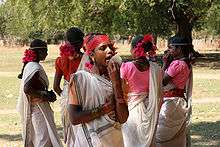Muria people


The Muria are an adivasi (scheduled tribe) of the Bastar district of Chhattisgarh, India. They are part of the Gondi people. Traditionally they are economically homogenous and strive to work as a collective. They have mixed-sex dormitories where adolescents are sent to practice premarital sex, sometimes with a single partner and sometimes serially. They have an omnivorous diet, with liquor playing a key role in their society.
Etymology
Shiva Tosh Das writes that the name Muria comes from the root word mur, which can be translated as either "root" or "permanent"; it may be based on the fact that the Muria are settled, unlike the nomadic Maria.[1]
Social structure
The Muria prioritize collectiveness.[2] They are divided into five phratries: the Nagvans (Snake Race), Kacchimvans (Tortoise Race), Bakravans (Goat Race), Baghvans (Tiger Race), and Bodminkvans (Fish Race).[3] They are not allowed to eat their totem animal, and must mourn it if one dies.[4]
Costume


Male Muria wear clothing similar to that of the Chanda District, while the females often dress in simple garments that do not cover the breasts.[1] The style of the garments appears to have been modified after contact with other tribes.[5]
Location
The Muria live in the north-central part of Bastar district, north of the Indravati River,[6] located in Chhattisgarh state in central India.[7] They live in two administrative divisions: the Kondagaon Tehsil in the east and the Narayanpur Tehsil in the west.[6]
Economy
Compared to other adivasi, the Muria are relatively prosperous.[7] Their economic stratification has traditionally been homogeneous, with exceptional consumption outside of designated periods, such as feasts, viewed as "socially threatening, hubristic, and disruptive"; conspicuous wealth has been considered to cause more problems than it solves.[8] Alfred Gell writes that the disparity between their perception of the ethics of consumption and modern production technology has caused some to have more wealth than they are willing to spend.[7]
Sexuality and marriage
The Muria embrace sexuality from a young age. Youths are sent to mixed-sex dormitories called ghotul, where they live in close quarters and are expected to engage in sexual activities, up to and including intercourse; this expectation does not extend to group sex, which is discouraged.[9] In some ghotul, adolescents are put in monogamous relationships; in others they are discouraged from becoming emotionally attached to their partners, and those who sleep together for more than three nights are punished.[10] Although having privacy for intercourse is considered important, it is not deemed a necessity.[9]
Prior to engagement, Muria men may freely engage in sexual intercourse with their mother's brother's daughter or father's sister's daughter, while women may do the same with their father's sister's son or mother's brother's son; this is not allowed after betrothal. Women may freely grab each other's breasts or exchange sexually themed jokes, a custom which becomes more common as they get older.[4]
The Muria generally marry late[11] and do not pay dowries.[12] They are not allowed to marry from within their own clan, although a Muria man may marry his cousin; cousin marriage is common, with Muria men often marrying their mother's brother's daughter or father's sister's daughter.[13]
Diet
The Muria are generally self-sufficient in producing and consuming dal, chickpeas, and lentils. Vegetables, including radishes, eggplant, chili, and tomatoes are eaten during important ceremonies; rice is also eaten at these times. Luxury foods for the Muria tend to be traditional. The Muria people drink a local form of liquor, which plays a key role in social and ritual gatherings.[14]
Religion
The Muria are traditionally animists, with village and clan deities.[11]
References
Footnotes
Bibliography
- Das, Shiva Tosh (1989). Life Style Indian Tribes: Locational Practice. 3. Dehli: Gian Publishing House. ISBN 978-81-212-0058-5.
- Gell, Alfred (1986). "Newcomers to the world of goods: consumption among the Muria Gonds". In Arjun, Appadurai. The Social Life of things: Commodities in Cultural Perspective. Cambridge: Cambridge University Press. pp. 110–40. ISBN 978-0-521-32351-2.
- "Premarital Sex". Sex and Society. 3. New York: Marshall Cavendish. 2010. pp. 663–66. ISBN 978-0-7614-7908-6.
| Wikimedia Commons has media related to Muria people. |